Your cart is currently empty!
Boating with a Dog on America’s Great Loop
Boat Dog Accessories
As we left land life and transitioned to boat life, we wanted to comfortably transition Ollie to her new day-to-day life. There weren’t many things we did to transition Ollie, however, these are a few considerations we took into account:
1. Dog Life Jacket
We bought Ollie a life jacket with a handle on her backside. Just in case she did fall in the water either from the boat or the dinghy, we would have an easy way to get her out. This has been a total game-changer for us as she’s fallen into the water every now and then, but it no longer phases us or Ollie as we’re able to quickly and easily get her back on board. We highly recommend getting your dog a lifejacket and putting it on for every cruise or water excursion! BoatUS tested several dog life jackets on a variety of different aspects, which may help in your purchasing decision.
Ollie’s Life Jacket
…she wears this everyday we’re cruising!
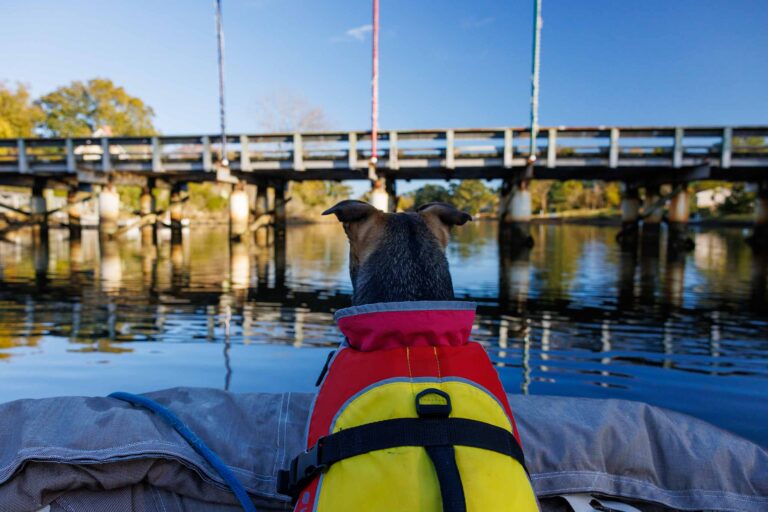
We bought Ollie’s West Marine Deluxe Pet Life Jacket at a used boat parts store, but you can still find them here. If we were buying a dog life jacket new, we’d purchase the Ruff Wear Float Coat because it’s the same brand as her harness and we like the quality of it. You can find it here:
2. Dog Bathroom
One of the many ways we’ve tried to get Ollie to do her business on the boat was astroturf (see below for more on this topic). We built a 1’x3’ box with astroturf so Ollie can do her business. Although she doesn’t use it for its intended use and instead uses it as a bed, we continue to practice and work with her.
Ollie’s Bathroom Mat
…Ollie doesn’t always go to the bathroom on the boat but when she does, she goes here.
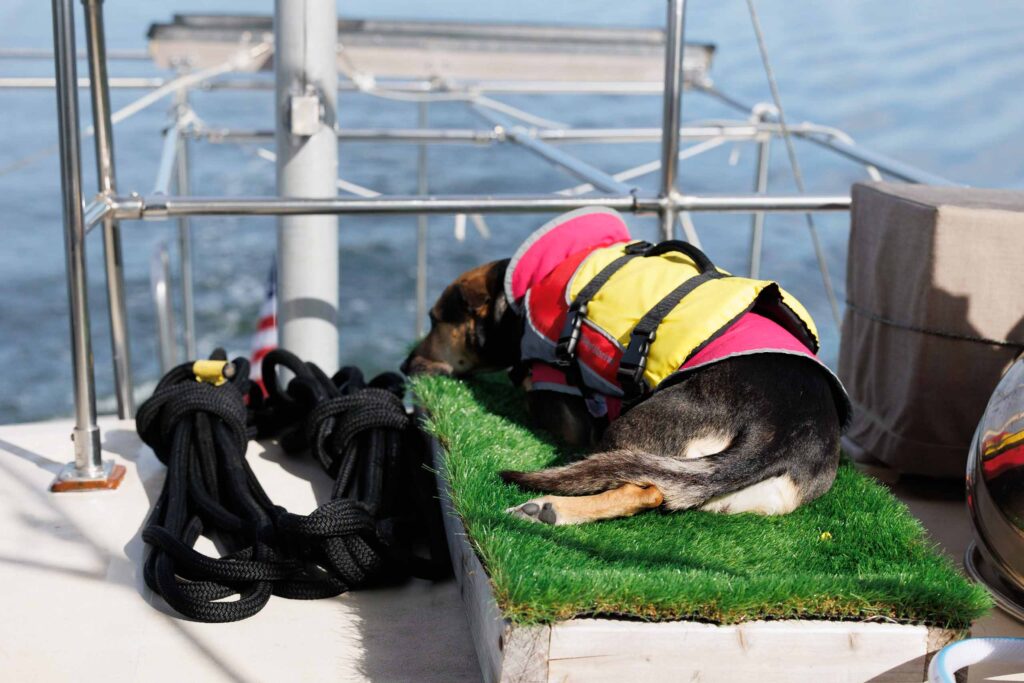
Buying an astroturf matt with a tray would have made our lives a lot easier.
3. Dog Jacket
Temperatures vary along the loop. Within one month you could be enjoying warm 75 degree weather in the Florida Keys and at the end, 40 degrees and raining in North Florida. A dog jacket will help keep your furry friend warm and comfortable as the weather changes.
Ollie’s Jacket
… being warm on the water isn’t just for the humans.
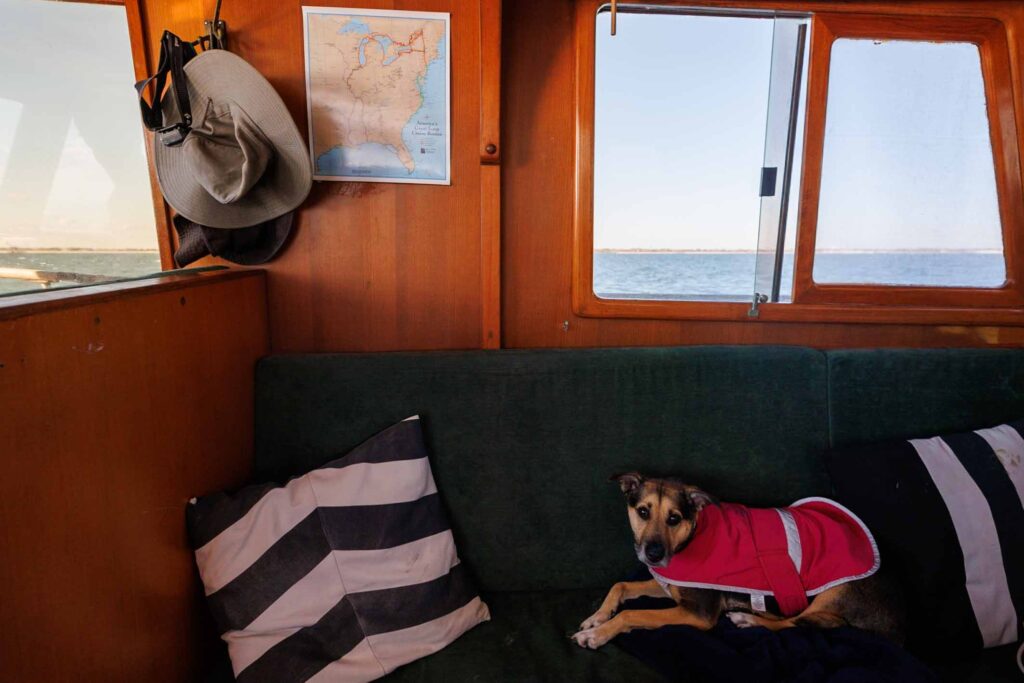
We bought Ollie’s life jacket prior to traveling full-time from LLBean. but you can still find them here.
If your furry friend sincerely dislikes water, you could get them a rain jacket!
4. Ramps or Dog-Friendly Ladders
Does your dog like to swim? If so, knowing how will your dog get from the water back onto your boat is crucial. Depending upon the layout of your boat, you may or may not have a dog-friendly swim platform, giving you leverage to get your dog on or off your boat. For us, Ollie is not a big swimmer, but for other dogs who love to swim, it’s important to think about how your dog will get back on board safely.
Dog-Friendly Swim Platform
…if Ollie swam off the boat, she’d probably want to get back on the boat.
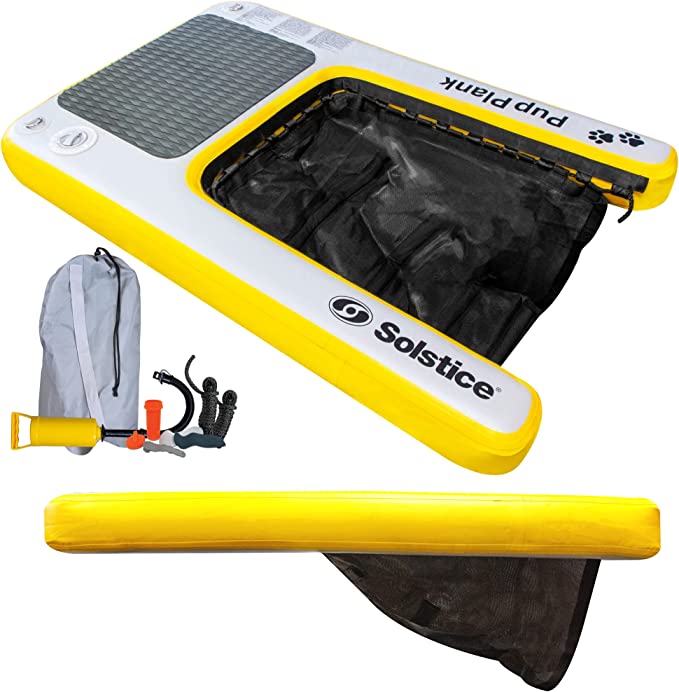
Ollie does not enjoy swimming from the boat, however, if your dog enjoys jumping off the boat, it’s essential to consider how they will get back onto the boat. It might be difficult to carry larger dogs onto the boat, so getting them an inflatable ramp would allow them to get back on the boat without difficulties or posing any safety concerns.
5. Extra Water Bowl
Ollie has her primary food and water bowls inside, but we’ve also included a second water bowl on our flybridge so she always has access to drinking water to stay hydrated.
Ollie’s Dog Bowl
Keeping Ollie hydrated, where ever she hangs out…
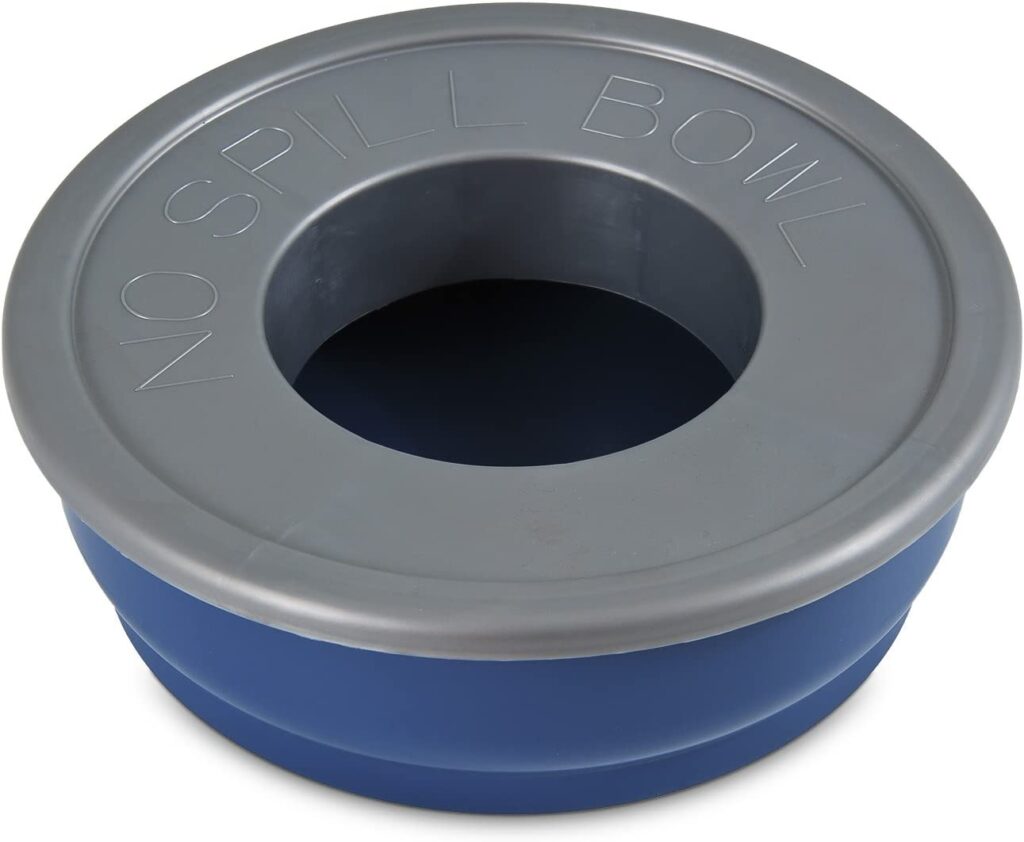
We bought Ollie’s extra dog bowl onto the boat, but if you’re in the market for another dog bowl, this dog bowl is spill resistant. Great for keeping your decks dry.
6. Outdoor Dog Bed
We added an extra bed on our flybridge so Ollie has a place to sit with us. It stays in our flybridge locker so we have easy access. Although it’s not specifically made to be outdoors, we designated it as her outdoor dog bed.
Ollie’s Dog Bed
…one of her favorite spots to nap.
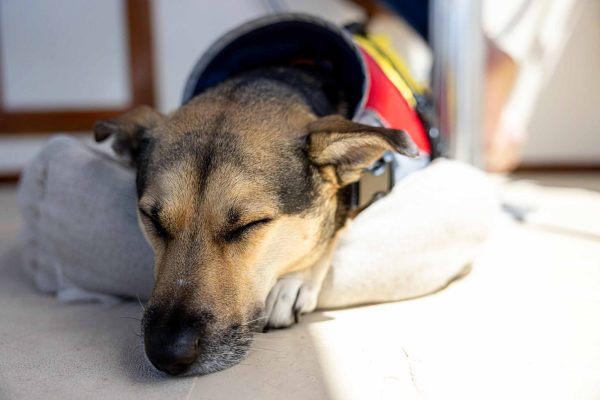
We bought Ollie’s bed from home and designated it as her “outdoor bed,” however, if you’re looking for a great outdoor bed for your dog you can find one here:
7. Cooling Pad
After we completed our loop in Florida, we spent 3 months hanging out in the Florida Keys with consistently warm weather. During that time, Ollie spent most of her days in the shade on our flybridge where she could get a cool breeze. There were many hot days that having a cooling pad for her to lay on would have made her a lot more comfortable. If you’re planning to cruise in Florida, the Bahamas, or the Caribbean outside of the winter months, consider getting a cooling pad for your dog.
Ollie’s Dream Cooling Pad
…Ollie would have appreciated this on those hot days.
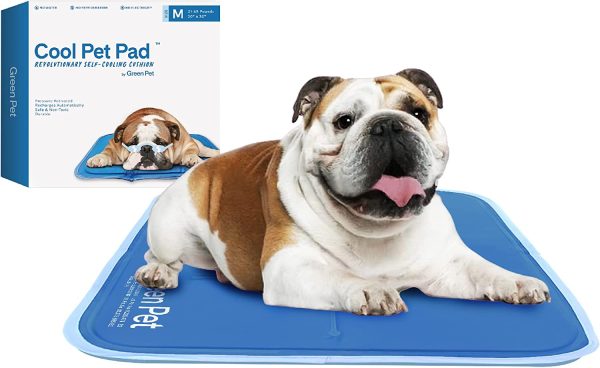
Although we didn’t get Ollie a cooling pad, we wish we did for those scorching hot days.
Boat Dog Rules
We have a few spots where we’ve implemented “Ollie rules” to keep her safe. Here are a few examples of our Ollie Rules:
- Any time we’re cruising, she must wear her life jacket at all times. This is for both our trawler and our dinghy.
- In any water activity (i.e. paddle boarding or kayaking), she must wear a life jacket.
- Ollie is not allowed to have four paws on the wooden area by our anchor while we’re cruising. It’s to make sure she doesn’t slip and fall.



How Often We Take Our Dog to Shore
On land with traditional 9-5 jobs, we took Ollie out to do her business about 3x/day. Cruising full-time and trying to keep a certain pace while on America’s Great Loop means we can’t stop 3x/a day for her to use the bathroom. We would waste a lot of time finding a spot to anchor, anchoring, preparing the dinghy, going to shore, walking Ollie, going back to the boat, unloading the dinghy, and pulling up our anchor. As a result, we take Ollie out twice a day. With each of those trips, we try to give her a decently long walk to give her and us some exercise, stretch our legs, and allow her to get all the good sniffs in while on land. Depending upon our cruising schedule and weather for the day, Ollie goes to shore at various times of the day.
Where to Take Your Dog to Shore
There are two main ways to take your dog to shore: anchorages and marinas. Marinas are pretty self-explanatory, but finding a dog-friendly anchorage can be a bit more of a challenge (see below). During the times we can’t take Ollie to shore for a lack of shore access, we have a few emergency options for her to do her business on the boat (also explained below).
How to find Dog Friendly Anchorages
We make it a priority to search for dog-friendly anchorages as we travel. Sometimes it’s easier said than done. We take Ollie to shore twice a day; once in the morning and once at night. Overall, she does well with her two-a-day schedule, however, she can hold her bladder longer. Taking Ollie to shore twice a day has become our normal routine.
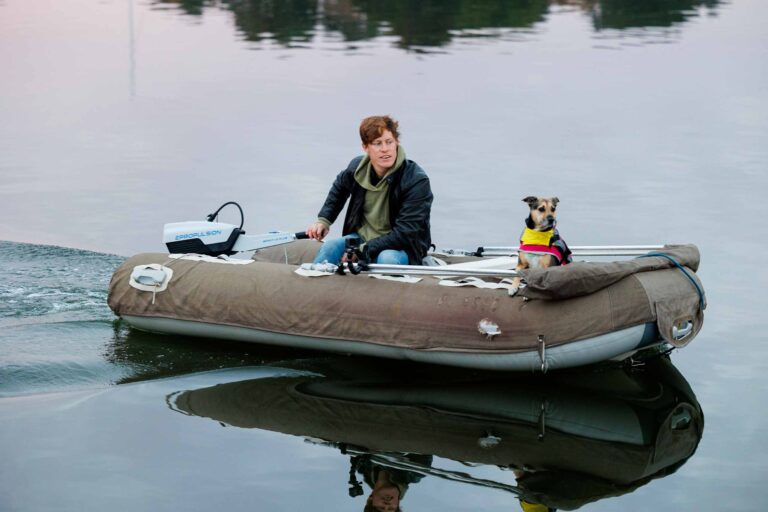
Ollie rarely does her business on the boat even though we’ve tried to encourage her to go. Some areas on the loop are more dog accessible than others to take a dog to shore from an anchorage, but this is our general strategy for searching for dog-friendly anchorages.
- Public boat ramps
- Free city docks
- Dog-friendly, sandy beaches
We use Active Captain to look for dog-friendly anchorages. By clicking on the green anchorage symbol, you can gain information about the amenities of that anchorage, including pet access. We also read the comments to see what others have said about the anchorage and accessibility for pets.
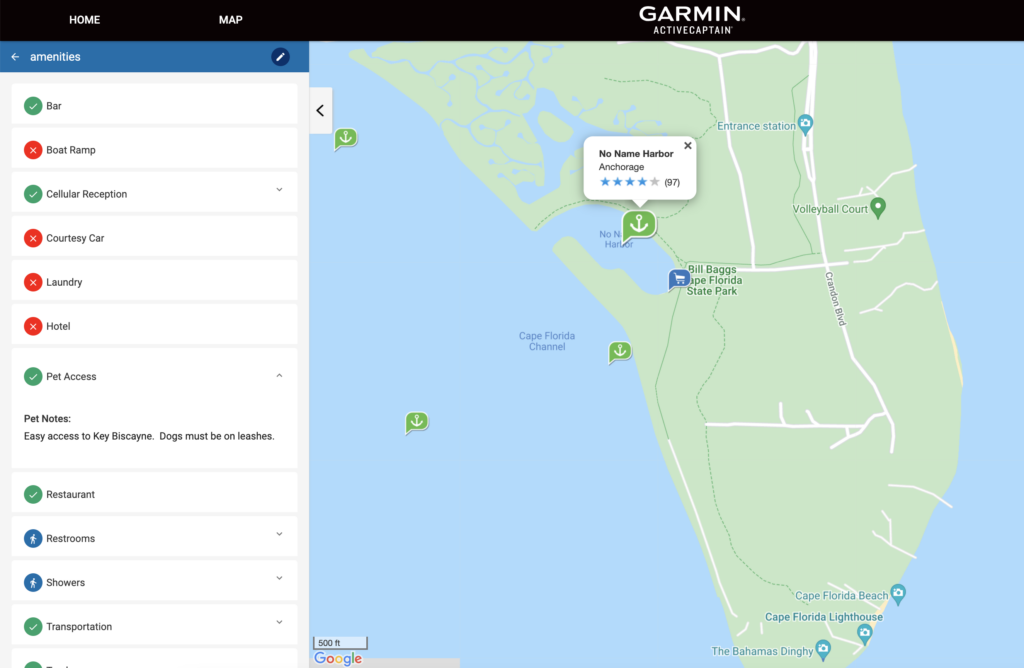
How to get your dog to do “Business” on the Boat
In our experience having a dog do its business on the boat is a rarity. We’ve gotten to know a lot of other dog boat cruisers in our year of cruising, and the majority of boaters have similar challenges with getting their dogs to do business on the boat. As we’ve spoken to more cruisers about their dogs, we’ve picked up a few tips and ideas for how to get your dog to do their business on the boat. We’ve tried various techniques including ideas from other cruisers. Here are some of the different ways to get your dog to do business on the boat:
Rope
This recommendation came from a fellow boater. Coil a piece of rope on the stern or bow of the boat and encourage your dog to do its business there. The benefit is once the dog does their business, you’re able to clean off the rope by tossing it into the water for a minute and then bringing it back on board and recoiling it. We did try this method, however, it did not prove successful with Ollie.
AstroTurf.
We built a 1×3 foot box with astroturf for Ollie to do her business. She has only used it a handful of times when we’ve pushed her “holding capacity,” as she would much prefer to go to land. She often uses the astroturf as a bed, but it’s something we’re continuing to work on with her. We have tried putting her urine and feces on the astroturf to make it smell enticing, but it hasn’t done the trick.
Rug.
This recommendation came from another fellow boater. Their suggestion was to purchase an old rug and lie it on the bow or stern. Practice with the dog to use the rug as their spot to do their business.
A bush.
This recommendation came from another fellow boater. They bought a bush and kept it watered for several hundred miles because their male dog liked to pee on things. We did not try this suggestion.
Dog Pee Pads.
We bought dog pee pads in hopes of the “smell” that comes from the pee pads would attract Ollie to do her business. Since she was not trained with pee pads, this method did not prove successful.
Pheromone Spray.
We bought dog pheromone spray and used it on Ollie’s astroturf pad in hopes of enticing her to go. Although the smell does entice Ollie’s curiosity, it has not proved successful to get her to do her business on the astroturf box.
Practice, Practice, Practice!
There’s no secret sauce or magic pill; the best thing is repetition, practice, and patience. We’re consistently working with Ollie for her to use the astroturf and do her business on our boat. During extended times of not having dog shore access, Ollie has had accidents inside. It’s not fun cleaning up her accidents which lead to the bilge, but we know we’re all doing our best. In the two times she has done her business on the boat, and on the astroturf, we have showered her with treats and high appraises.
As you can see, we’ve tried a variety of methods with Ollie. During our trip from Chesapeake City, MD to Staten Island, NY, over the course of nine full days, we did not go to shore once and she did her business on the boat seven times. Here’s what we did and learned:
- This time allowed us to practice working with Ollie. We walked her to the bow, multiple times throughout the day, showing her the astroturf mat at our bow.
- This extended period of time surpassed the time she could hold her bladder and therefore she did her business on the boat.
- Every time she ended up going to the bathroom on the boat, we would reward her with a ton of dog treats! Reinforcing the behavior we wanted.
- After this extended period on the boat, Ollie did continue to use the bathroom on the boat only after not going to shore for 24 hours or more.
Today, we continue to take Ollie to shore twice a day, once in the morning and once at night, each with a decently long walk. If you have any tips or suggestions for getting your dog to do their business on the boat, please let us know in the comments below!
Key takeaways: what works or doesn’t work for our dog, Ollie, may or may not work for your dog. It’s all about trial and error. Through experimentation, practice, and a lot of patience, we hope you’re able to find success in having your dog go to the bathroom on the boat. We’d highly recommend that you try out several of these techniques with your dog prior to leaving on your grand adventure as it will make the transition a lot smoother.
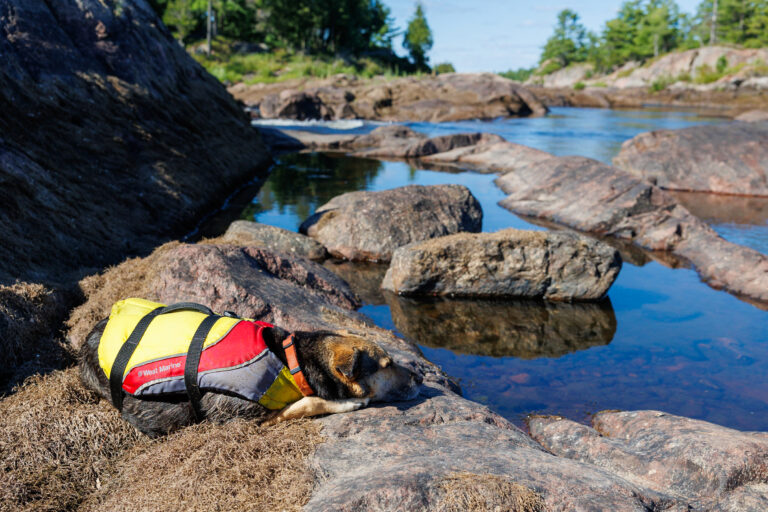
International Dog Travel
One of the really neat things about traveling with your dog on America’s Great Loop is having them join you as you travel to different countries. Traveling to Canada and the Bahamas is a personal choice in someone’s travel itinerary, and not required by any means, however, it can be a real highlight of the trip. Here are a few resources for the travel requirements for Canada and the Bahamas.
Traveling to Canada with your Pet
You can find out more about bringing your pet with you to Canada on their government website. The main consideration with bringing your pet into Canada is that a valid rabies vaccination certificate is required. With a few questions, you can find out additional information as it pertains to your pet and specific situation.
Traveling to the Bahamas with your Pet
You can find out more about bringing your pet with you to the Bahamas on their government website. The main consideration with bringing your dog or cat into the Bahamas is that your pet needs to be up to date on vaccines and have a recent vet health check-up. An application and fee is required before arriving.
Although we have not traveled to the Bahamas with our pet, our friends from Abroad Reach Travel have! They live full-time aboard their 37 Tartan Sailboat with their dog, Aiden. In their experience, the pet permit takes 7-10 days to get approval. Once you get approval, you need to get your pet a health certificate 48 hours before your planned arrival. They have personally worked with Wellington from Bahamas Pet Permit twice. Bahamas Pet Permit requests 10 days for turnaround, however, in their experience, they receive the permits within about 4 days. The price is cheaper than if you did it through FedEx to mail it yourself. The permit is good for up to a year so you can apply at your convenience and then do the health check no more than 48 hours prior to your arrival.
Dog Packing List
Ollie is a fairly easy dog and doesn’t require much. The three things we made sure we had with us prior to entering Canada were:
- Extra Food – Since dogs do best eating their brand and type of food consistently, we made sure to have an extra bag with us.
- Medicine – We made sure to have anti-pain, anti-nausea, and antibiotics prescribed by our veterinary back home prior to departing for this trip.
- Documentation – We made sure to have original copies as well as digital copies of Ollie’s medical information.
All Dogs are Unique
Not all dogs are the same, so it’s important to know your dog. Does your dog like it warm or cold may depend on if your dog has long or short hair. We know that Ollie doesn’t do well in super hot weather, so when we do have hot days aboard PIVOT, we make sure to get our fan out and point it on her, make sure she’s in the shade, and ensure that she has plenty of water to drink. We don’t leave her on the boat for extended periods if the weather is too hot. Our go-to rule is “if it’s too hot for us, then it’s too hot for Ollie.” Knowing what your dog likes and dislikes is important for transitioning them from a life on land to life on the water.
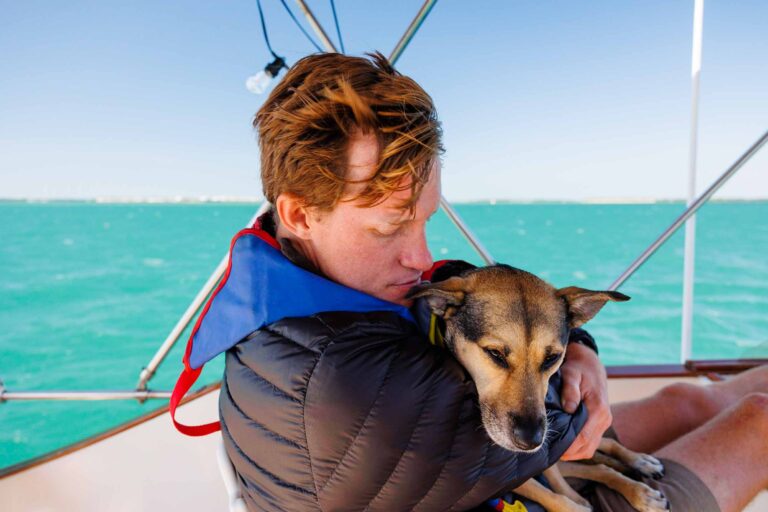
We decided to take our dog with us because we felt Ollie will have just as much fun as us, except more! She doesn’t get stressed out with the various challenges that we’re faced with on the water and enjoys the little things just as much as we do. She’s a great addition to our life on the boat and we wouldn’t have it any other way.
Do you have any questions? Leave us a comment below and we’ll try to answer them! Do you know of a boater with a salty dog that might find this information helpful? If so, send this article their way.
The ups, downs, and everything in between, we share it all. If you like what you see, there are lots of ways to show your support and say thanks! The easiest way to support our work is by commenting on this post, liking and sharing our content on Facebook, and pinning our content on Pinterest. It’s a small way to say thank you that goes a long way!
by
Tags:

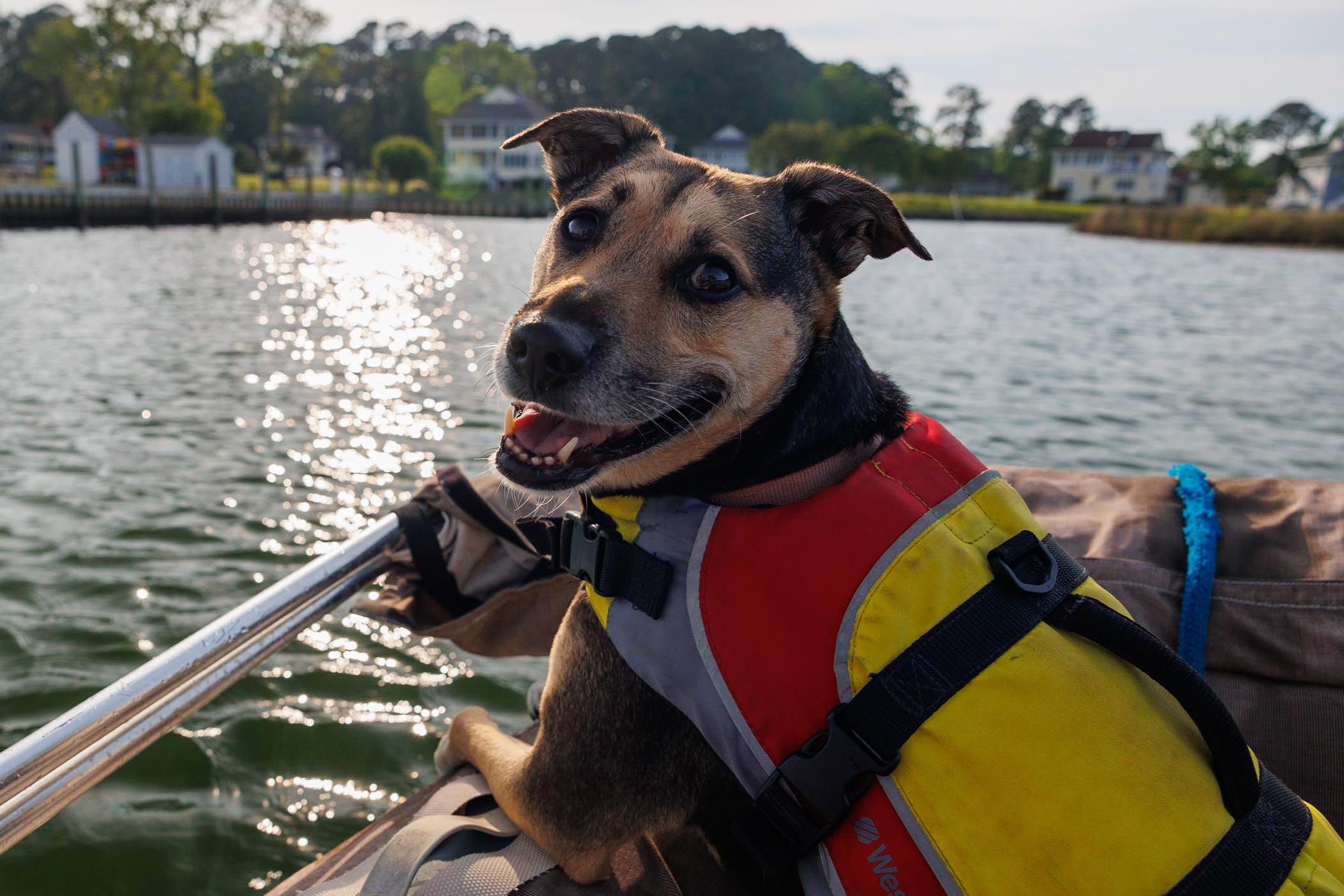
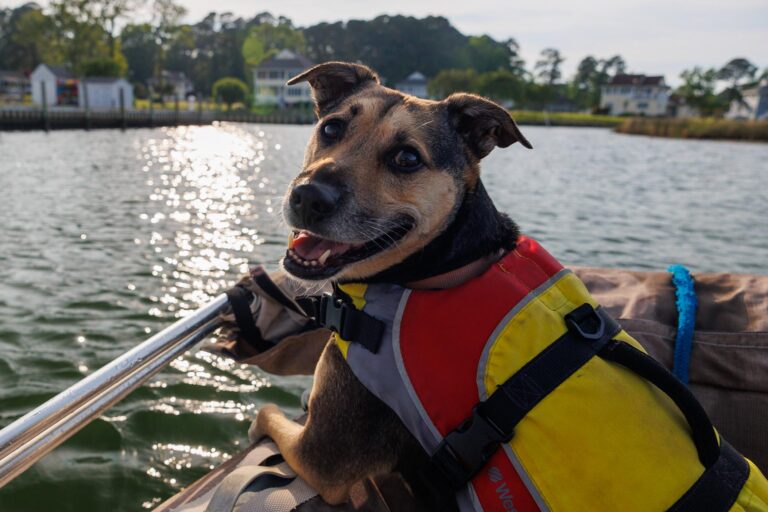
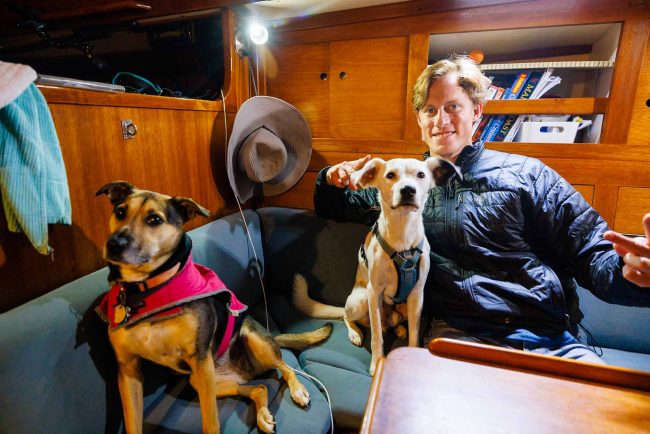
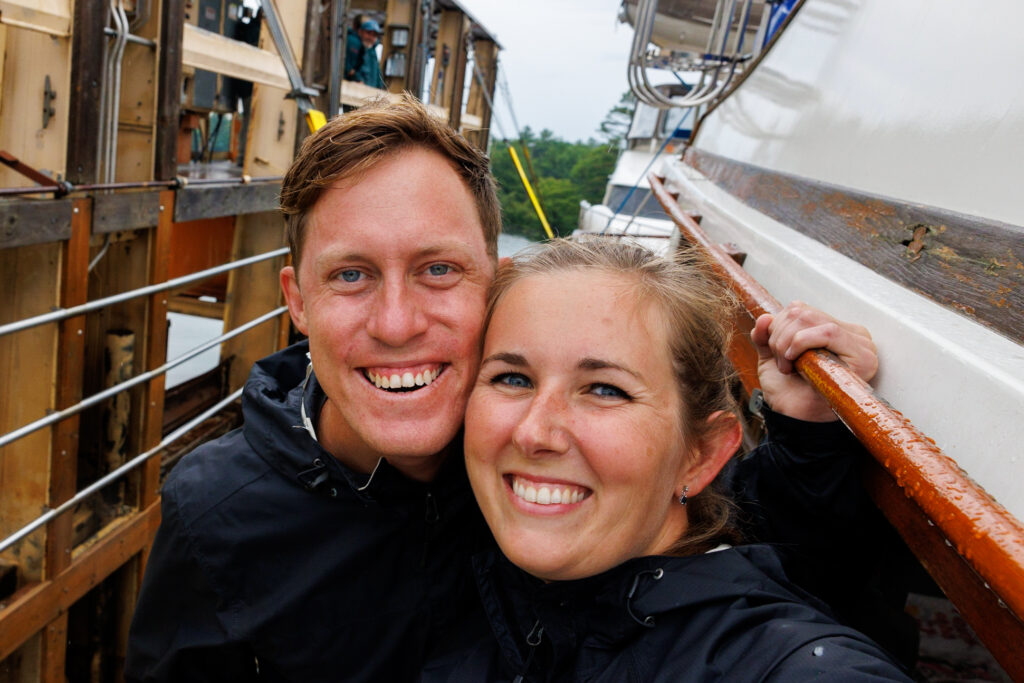


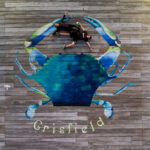


Comments
14 responses to “Boating with a Dog on America’s Great Loop”
I have been following your journey since the start mainly because of Ollie. I rescued my 5 year old Fox Hound in December, she and I will leave the RI area in early June. She has only been on the boat while on the hard but is very comfortable. She is about 50 lbs and lets me carry her up and down the ladder. I am going try using the rug, because she was a breeding dog she lived in a kennel. I had to train her to go outside. She will however pee on the rug if I let her in the one room with carpet. I and many others would love a list of dog friendly anchorages as you go along your way.
Hi Matt,
We were so sad to hear about Rossie when we met you in Grand Rivers, Kentucky! She seemed like a wonderful dog with a real connection to you.
We’ll be compiling our list of dog-friendly anchorages that we went to or that we heard about once we’re complete with the loop.
Do you have the “bring Fido.com “ app on your phone. Great app for when you’re ashore with Ollie. Have used this quite a few times.
Hi George! We have not used the Bring Fido app, but I just downloaded it and it looks like a great resource. Thank you for sharing, we really appreciate it!
My husband and I have been following your journey and love watching your progression on The Great Loop. Does Ollie shed a lot and if so, how do you keep Pivot free from tons of fur? Any tips would be appreciated! Thanks!
Hi Nancy! Thank you for watching our videos; we really appreciate it.
Great question! Ollie is a short-haired dog, so she moderately sheds around the boat. I usually sweet and vacuum PIVOT once or twice a week to keep it neat and tidy inside. It’s an ongoing task, but we’re grateful to live in a tiny home so the cleaning doesn’t take very long.
Thanks for the great article. We took our two small dogs on a week long house boat trip. Prior to going, I thought of ways different for my two dogs for potty time. So I purchased a 5 gallon bucket from Home Depot and went to a nearby dog park and filled it with sand that had a well used smell by the dogs. I also got a door entry way rubber mat (4×4 size) and poured half of the bucket onto the mat. One dog used it all the time, poop and pee. The other dog was scared of it. Or plans are working towards a boat and traveling the loop. Thanks again.
Great idea to get “good smelling” sand and use that to entice your dogs to do their business on the boat! We’ll have to try something similar with Ollie and see if that proves successful. Thank you for sharing!
Hi Jen, Elliot and Ollie,
We love watching your videos and getting your weekly newsletter.
I have experienced many of your emotions and feelings, Jen, as we have learned to handle our trawler that we live on in Seattle with our dog Bella, (who looks a lot like Ollie.) You are very brave and kind to share your emotions so openly.
Like Ollie, Bella shakes when we experience rough water. I have tried a few things that have helped her tolerate the rough water:
-Hoping to help Bella connect positive feelings with the rolling motion, I give her treats constantly during rough passages (once every 5-10 seconds in the beginning of our training). I throw the treats on the floor without looking at her and I use cat food because the nuggets are small. This allows her to eat a whole lot of them without getting full. Bella is very food motivated and has learned to tolerate all but our roughest passages.
– If the treats don’t work, I take her downstairs and lay with her on the bed, (with my eyes closed so I don’t get seasick.) That is the place that has the least amount of rocking. Sometimes I treat her there too.
-Sometimes she will sit with me on the couch and take treats as well.
– The noise of thing crashing to the floor is upsetting to both Bella and I so I secure everything, (refrigerator, computers, appliances, etc) each time we go out regardless of weather. We lost our TV on one of our first trips just by being waked by a fast boat.
I feel terrible when Bella shakes which makes a rough passage even more upsetting to me.
Hope Ollie is not vomiting as much as she was before.
Suzanne
Our dogs would NOT use the astro turf when we first moved onto our boat. We bought a 2′ by 3′ piece of sod from the hardware store. It worked immediately! The sod was sitting on top of the astro turf. We think this is what helped with the transition. Slowly over a few weeks, we cut the sod smaller and smaller. Once we threw away the last little piece, they were using the fake grass! Ollie, tell Mommy and Daddy to try it!
Hi Cindy,
Love your idea for using sod as a transition material for the astroturf. We’ll definitely need to give that a try 😊
Hi Jen and Elliott, we are also on the Great Loop with our Shih Tzu dog Frodo. Frodo did not like to touch the astroturf so we kept the tray and filled it with a piece of sod. That was better, but he thought it was for sitting on and lying on. I asked a friend to have her dog pee on it – she did it first try! After that, Frodo was very interested but he still didn’t want to go on the boat. We moved the tray to the dock and he used it! He’s used it a few times on the dock but still not on the boat. Unfortunately we had to get rid of the grass when we left Canada. We’re half way down Michigan and haven’t found sod yet. I hope we don’t have to start over!
Frodo starts shaking every time the engines run, but he’s started calming down toward the end of a run. The meds don’t seem to work except to make him sleepy after we have arrived!
Hello Jen and Elliott! While practicing for our loop start next spring, we visited the Dismal Swamp visitor center, and while walking our dog, we met a wonderful gentleman who highly recommended Bark Potty for a dog on a boat https://barkpotty.com/ – haven’t tried it yet but we will soon!!
Hi Chad and Bev!
Ohh, we have not heard of the Bark Potty but will definitely need to give that a try! Thank you so much for thinking of us and sharing it 😊